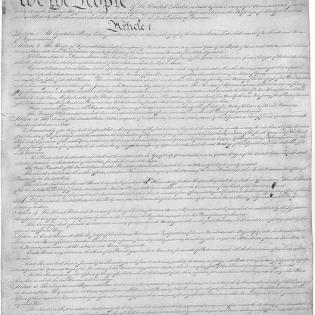What Does the Constitution Say about Philanthropy?
Students explore the components of the Preamble of the U.S. Constitution and apply them to their own lives, with a particular emphasis on philanthropy. This lesson is designed for Citizenship/Constitution Day (September 17) and connects students to the community-building focus of the Constitution and how it relates personally to their lives and action.
The learner will be able to
- identify the purpose of the U.S. Constitution.
- define language in the Preamble.
- give examples of actions they can take for the common good, and define philanthropy.
- recognize their own roles and responsibilities in civil society.
- projector and Constitution PowerPoint (handout below)
- student copies of Constitution Vocabulary handout below
- philanthropy: giving time, talent, money/objects, or using one's voice to make a difference for the common good
- more perfect Union: the laws established will keep improving our country
- justice: rules, actions, and attitudes designed to be fair to all people
- domestic tranquility: peace at home
- general welfare: what is best for the most people involved
- liberty: freedom
- posterity: people that come after us; the future course
Instructions
Anticipatory Set
Open up class proclaiming, “Happy Constitution Day!” Wave a flag and have fun with it. Then ask students, “What is Constitution Day?” and, “What should be celebrated?” Listen to their ideas, leading to a discussion about the importance of the Constitution and our roles in promoting the good of all.
Go through the Constitution PowerPoint (handout below).
- Slide 1:Tell the students that Constitution Day is a unique, special day in the United States.
- Slide 2: Give a brief description on the basics of what the Constitution is.
- Slide 3: Before you play the Schoolhouse Rock song about the Constitution, tell them to listen for the purpose of the Constitution when it was written and today. Play song once or twice. Discuss.
- Slide 4: If the Schoolhouse Rock song is familiar, have students sing the Preamble, otherwise read it together once or twice, asking the students to think about the meaning of the red words in context.
- Slide 5: Discuss and define the six terms, go back to the previous slide, as needed, to read them in context.
Give each student a copy of the Constitution Vocabulary handout and guide students in discussion as they record their own responses. You have the option of making this a written assignment, or a discussion piece. (15 minutes)
Introduce the word philanthropy. When people take voluntary action for the common good, they are practicing philanthropy. A philanthropist gives time, talent, money/objects, or uses voice to make a difference.
Wrap-up class. Provide a synopsis of what was taught and emphasize what the Constitution is and the ideas that are contained in the Preamble.
Quiz the students on the vocabulary words using quiz software or in writing.
Philanthropy Framework
-
Strand PHIL.I Definitions of Philanthropy
-
Standard DP 01. Define Philanthropy
-
Benchmark E.3 Recognize that citizens have a responsibility for the common good as defined by democratic principles.
-
-
-
Strand PHIL.II Philanthropy and Civil Society
-
Standard PCS 06. Philanthropy in History
-
Benchmark E.3 Describe important events in the growth and maturation of the civil society sector in the nation.
-
-
-
Strand PHIL.III Philanthropy and the Individual
-
Standard PI 01. Reasons for Individual Philanthropy
-
Benchmark E.5 Give examples of actions students can take to improve the common good and list or describe responsibilities that go with those actions.
-
-
